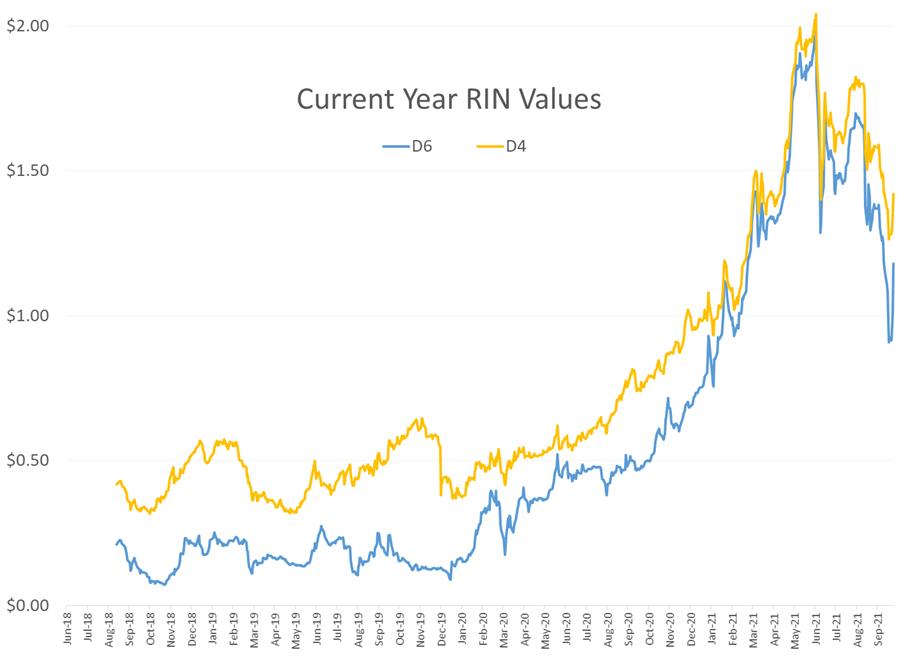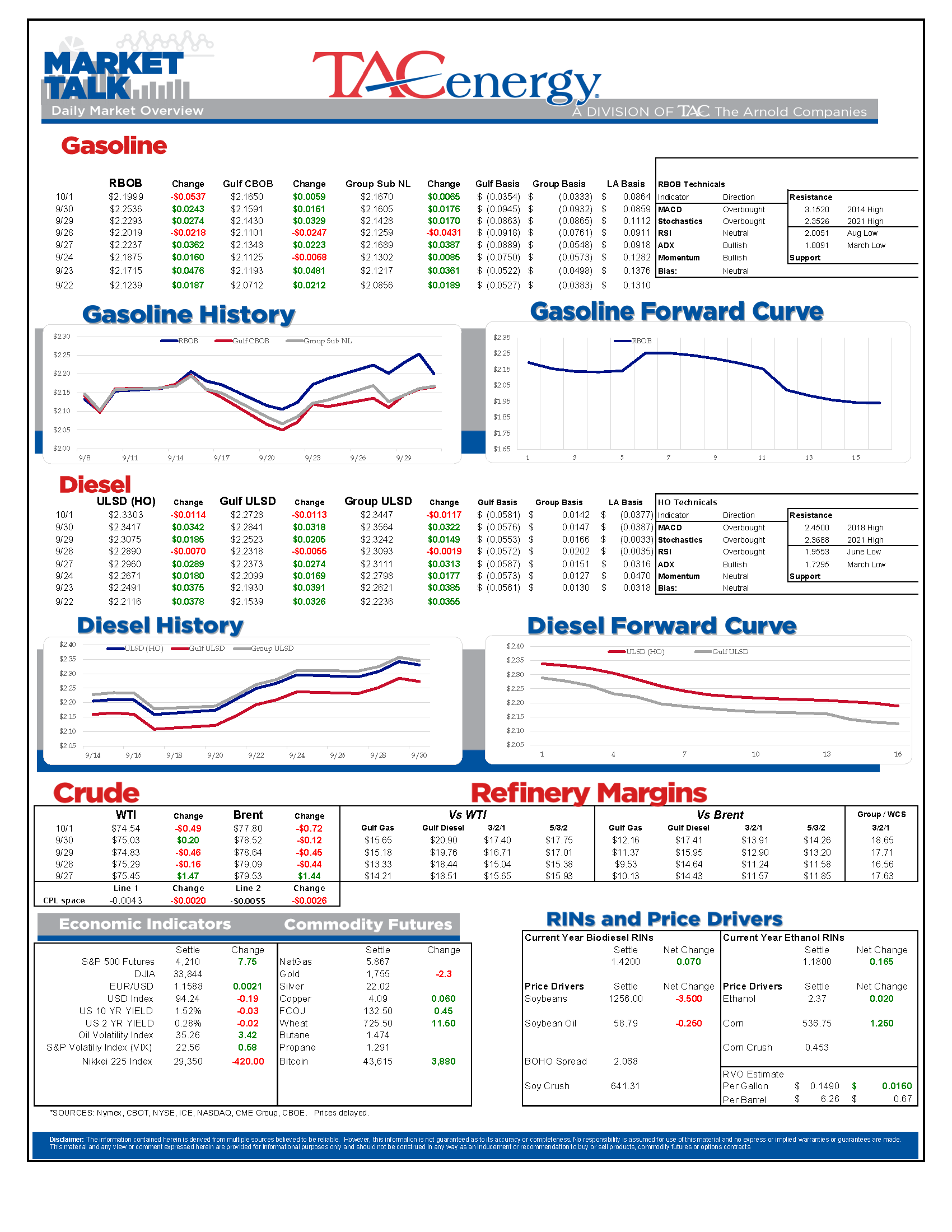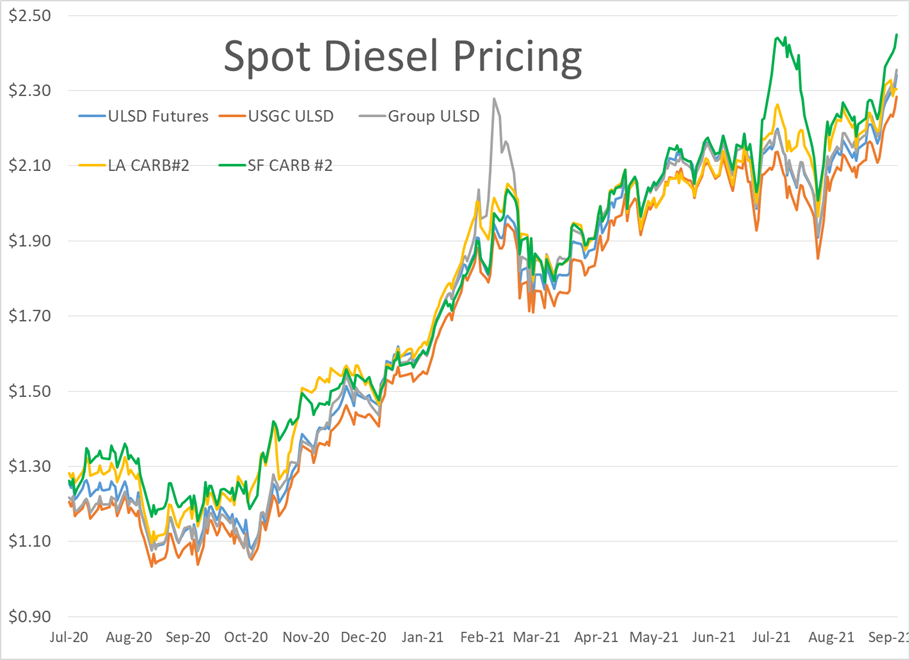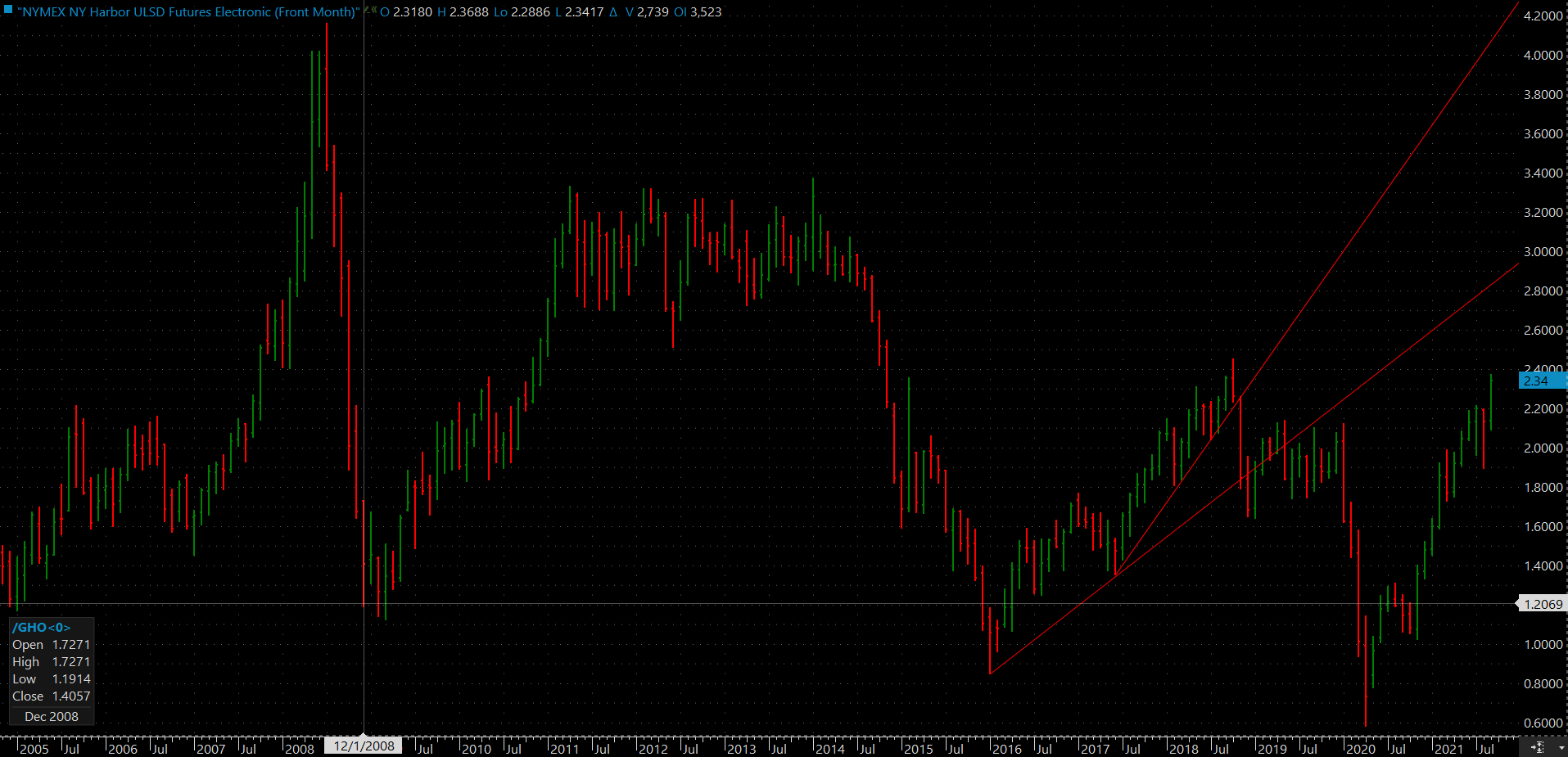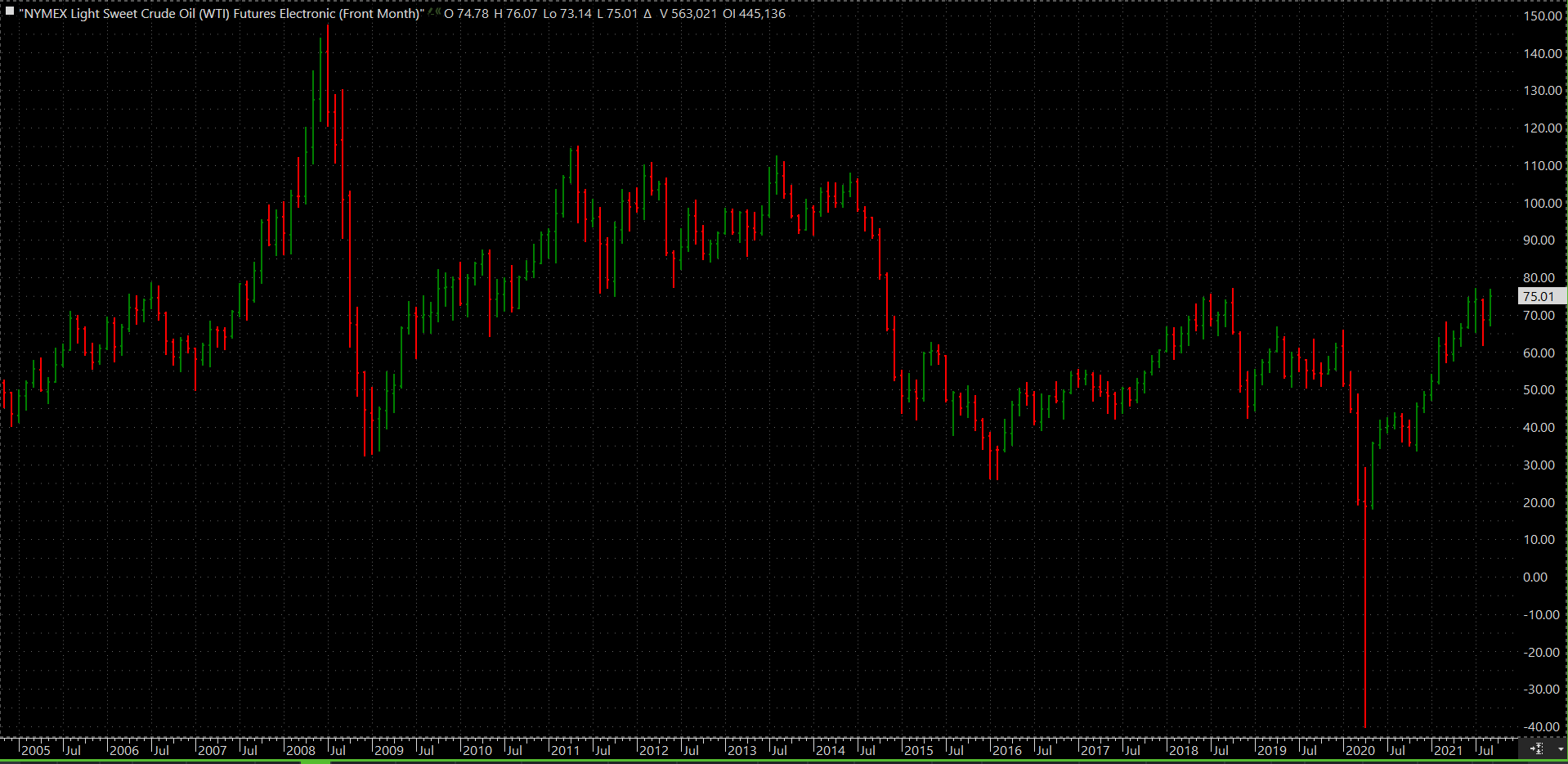Roiling Markets Around The Globe

A big Thursday reversal saw an 8 cent bounce from an early selloff in refined products, which pushed ULSD and crude prices to fresh 3 year highs. Government intervention, or the lack of in some cases, is the theme of the week roiling markets around the globe. The US government seems to have gotten out of its own way to avoid the latest debt ceiling stand-off, but remains gridlocked on longer term spending & tax bills, not to mention the RFS rulings that are already almost a year overdue.
The big story Thursday was the Chinese government has reportedly ordered energy companies to secure supplies “at all costs” this winter, reminding many market veterans of a similar plan that helped oil prices reach record highs 14 years ago. Here’s the cliff notes:
2008: Beijing hosts Olympics: Chinese government mandates fuel suppliers stock up ahead of the games to ensure no outages on the world stage. WTI reaches $147 and ULSD surpasses $4 in the months leading up to the games….before crashing to $32 and $1 later in the year as the world financial markets get hammered by housing & banking crisis, and Chinese suppliers stop their artificial purchases.
2022: Beijing host Olympics: Chinese government orders fuel suppliers stock up ahead of the games to ensure no outages on the world stage, coal and natural gas prices trading at record highs, crude and diesel prices reach 3 year highs.
Does this mean we’re in for another record high in oil and diesel prices? Some options traders are definitely betting that way as $200 call options on Brent have been trading this week.
Three big reasons why this time the Chinese fuel hoarding will be different than the last time, and why $200 (or even $100) seems like a stretch:
First, OPEC & the US have a combined 10 million barrels of spare capacity for oil production, which in 2008 was less than 2 million barrels.
Second, international spectators won’t be allowed at the games due to COVID, so the desire to window dress for millions of spectators may be substantially less than it was 14 years ago.
Third, most of the globe is still dealing with a refining capacity overhang, meaning that if prices continue to rally there will be an incentive to figure out a way to get oil or diesel on a boat and make money to solve the problem, and perhaps offer a life line to those refiners who have been contemplating shutting their doors.
Of course, we’ve seen plenty of evidence this year that turning spare capacity back on isn’t like flipping a switch, and logistical hurdles mean new supplies will take at least months to come back online. Here too the government intervention may get in the way as US drillers already struggling with worker shortages (like just about every other industry these days) are concerned that things could get much worse if vaccine mandates are passed.
While the China story earned much of the credit for the big price bounce on the day, it seems that another big rally in RIN prices may have been more of a factor as refined products outpaced crude gains on the day by a wide margin. There is still no official word from the EPA or the White House on the RVOs, and each day that passes without an update seems to be giving the market more confidence that the numbers “leaked” last week were fake.
Click here to download a PDF of today's TACenergy Market Talk.
Latest Posts
Energy Markets Rally Again Thursday After A Choppy Wednesday Session
Week 16 - US DOE Inventory Recap
Energy Markets Trading Quietly In The Red As Ethanol Prices Rally To Five-Month High
The Struggle For Renewable Producers Continues As A Rapid Influx Of Supply And Crashing Credit Prices Make Biodiesel
Social Media
News & Views
View All
Energy Markets Rally Again Thursday After A Choppy Wednesday Session
Energy markets are trying to rally again Thursday after a choppy Wednesday session. RBOB gasoline futures are leading the push higher, on pace for a 3rd consecutive day of gains after finding a temporary floor Tuesday and have added 12 cents from those lows.
Equity markets are pointing sharply lower after a weak Q1 GDP estimate which seems to have contributed to a pullback in product prices over the past few minutes, but don’t be surprised if the “bad news is good news” low interest rate junkies start jumping in later on.
The DOE’s weekly report showed sluggish demand for gasoline and diesel, but inventory levels in most markets continue to follow their typical seasonal trends. Refinery runs held fairly steady last week with crude inputs down slightly but total gross throughputs up slightly as most facilities are now back online from a busy spring maintenance season and geared up for peak demand this summer.
Propane and propylene exports spiked to a record high north of 2.3 million barrels/day last week, which demonstrates both the US’s growing influence on global product markets, and the steady shift towards “other” products besides traditional gasoline and diesel in the level of importance for refiners.
The EIA acknowledged this morning that its weak diesel consumption estimates reflected the switch to Renewable Diesel on the West Coast, although they did not provide any timeline for when that data will be included in the weekly survey. The agency acknowledged that more than 4% of the total US consumption is now a combination of RD and Biodiesel, and that number is expected to continue to grow this year. This morning’s note also suggested that weak manufacturing activity was to blame for the sluggish diesel demand across the US, while other reports suggest the freight recession continued through Q1 of this year, which is also contributing to the big shift from tight diesel markets to oversupplied in several regions.
Valero kicked off the Q1 earnings releases for refiners with solid net income of $1.2 billion that’s a far cry from the spectacular earnings north of $3 billion in the first quarter of 2023. The refining sector made $1.7 billion, down from $4.1 billion last year. That is a pattern that should be expected from other refiners as well as the industry returns to a more normal market after 2 unbelievable years. You wouldn’t guess it by looking at stock prices for refiners though, as they continue to trade near record highs despite the more modest earnings.
Another pattern we’re likely to see continue with other refiners is that Renewable earnings were down, despite a big increase in production as lower subsidies like RINs and LCFS credit values sting producers that rely on those to compete with traditional products. Valero’s SAF conversion project at its Diamond Green joint venture is progressing ahead of schedule and will give the company optionality to flip between RD and SAF depending on how the economics of those two products shakes out this year. Valero also shows part of why refiners continue to disappear in California, with operating expenses for its West Coast segment nearly 2X that of the other regions it operates in.

Week 16 - US DOE Inventory Recap

Energy Markets Trading Quietly In The Red As Ethanol Prices Rally To Five-Month High
Energy markets are trading quietly in the red to start Wednesday’s session after a healthy bounce Tuesday afternoon suggested the Israel-Iran-linked liquidation had finally run its course.
There are reports of more Ukrainian strikes on Russian energy assets overnight, but the sources are sketchy so far, and the market doesn’t seem to be reacting as if this is legitimate news.
Ethanol prices have rallied to a 5-month high this week as corn and other grain prices have rallied after the latest crop progress update highlighted risks to farmers this year, lower grain export expectations from Ukraine, and the approval of E15 blends this summer despite the fact it pollutes more. The rally in grain and renewables prices has also helped RIN values find a bid after it looked like they were about to test their 4-year lows last week.
The API reported small changes in refined product inventories last week, with gasoline stocks down about 600,000, while distillates were up 724,000. Crude oil inventories increased by 3.2 million barrels according to the industry-group estimates. The DOE’s weekly report is due out at its normal time this morning.
Total reported another upset at its Port Arthur refinery that’s been a frequent flier on the TCEQ alerts since the January deep freeze knocked it offline and damaged multiple operating units. This latest upset seems minor as the un-named unit impacted was returned to normal operations in under an hour. Gulf Coast basis markets have shrugged off most reports of refinery upsets this year as the region remains well supplied, and it’s unlikely we’ll see any impact from this news.
California conversely reacted in a big way to reports of an upset at Chevron’s El Segundo refinery outside of LA, with CARBOB basis values jumping by more than a dime. Energy News Today continued to show its value by reporting the upset before the flaring notice was even reported to area regulators, proving once again it’s ahead of the curve on refinery-related events. Another industry news outlet meanwhile struggled just to remember where the country’s largest diesel seller is located.
Click here to download a PDF of today's TACenergy Market Talk
